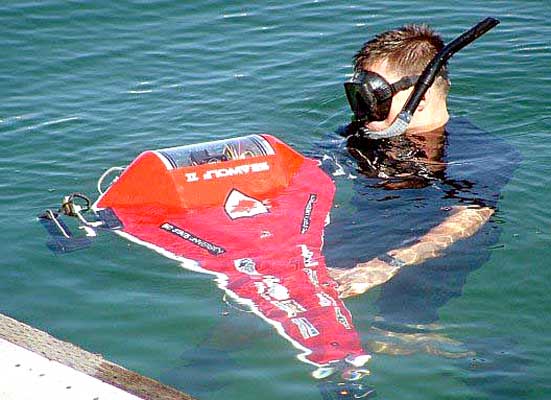The members of the underwater robotics club sit around a conference table on the third floor of Engineering Building I on Centennial Campus. In the middle of the table is a bright red machine that closely resembles the body of a stingray. Its sleek exterior boasts sponsorship stickers by companies like Ortex Holding, SolidWorks and Bojangles — a list that is continuing to build.
“We are working on a sponsor who makes underwater connectors,” said Frankie Myers, a senior in electrical engineering.
Myers is the team manager, rather then the club president. He wants to keep the club a team atmosphere, rather then complicating issues with strict roles, he said.
Sponsorship and dedicated members are the most important elements for the team to function, a realization that came after the challenge they faced in fall 2005. After the team’s first competition with Seawolf I, the company the team had worked with retracted their original robot and the team had to begin again.
“Early last year we took a break for a month and came up with ideas,” William Cox, a graduate student in electrical engineering, said. “We had a meeting and a long roll of paper. And after 25 feet of paper we had a design. We had a lot of pizza and caffeine.”
Cox pointed out there is always caffeine involved — especially during competitions.
This past summer was the second year the underwater robotics club participated in the Association for Unmanned Vehicle Systems International’s Autonomous Underwater Vehicle competition.
The mission for the 2006 competition involved three tasks. The robot had to enter through a docking station, identify an area on a pipeline to fix and then resurface in an area marked with buoys. Plus, it all had to be autonomous.
In 2005, the team finished second to last, but this past summer the team received ninth place overall.
Before both competitions the robots worked, but once the performance was being graded the machines begin acting up.
“The robot had worked perfectly all semester,” Cox said. “But the first time we put it in the water it went crazy.”
Myers described the motion of the robot.
“It went in circles, spiraled around, did a back flip and then floated to the surface like a dead bug,” he said. “It was pretty frustrating, but we had 15 minutes to get it to work and we tried it two more times.”
The third time was the charm as Seawolf II made it through the gate — enough to earn the team ninth place.
“There is a certain amount of voodoo magic to these things,” Myers said.
Cox and Alex Stewart, a junior in computer engineering, agree. Combined, they have been to seven competitions and they have never had a robot work to its full potential. And they aren’t alone — Myers said there were teams at the competition from Asia whose robots didn’t work when put in the water.
Frustrating is an understatement to describe the intense disappointment of so much work put into the underwater craft. The students worked full time this summer to prepare Seawolf II for competition.
Cox worked from 9:00 a.m. to 11 p.m. everyday this summer.
“I quit my job halfway through the summer so I could work on the robot,” Stewart said.
Stewart worked on the robot’s vision software. The robot had to be able to distinguish a red blinking light in order to mark the pipe in the competition.
The club took the robot to Carmichael Gymnasium to test the vision capabilities last year before the blinking software was installed. Instead of blinking, Seawolf II searched for something large and red — and it found a guy in red swim trunks and chased him around the pool.
The students also tested the robot in the University House pool.
“We had drunk guys coming out and being like, ‘Hey! can we swim with your robot?’ and asking if they could ride the robot,” Cox said.
Cox insists that it is possible to ride the robot — just one of the perks of the long hours they put in all year.
The real accomplishment for the club members is that they get to really produce something of their own, especially now that the robot is University owned, Myers said.
They also built their robot from scratch, an achievement that often leads to jobs in the real world.
“If you do aerial or land there are kits, but there are no underwater kits — you have to build everything from scratch,” Cox said. “It’s new territory.”
According to the club’s Web site, several alumni of the club have received job offers from companies in the robotics and defense industries including Lockheed Martin, Raytheon, Johns Hopkins Applied Physics Lab and the CIA.
And now the club veterans carry on — trying to find solutions to the problems that plagued the robot this summer. They have new ideas for their power system, having the robot hibernate when the power is low and possibly even a new camera system.
“I like this more than school projects — you can do whatever you want,” Chris Fletcher, a junior in electrical engineering, said. “There is a problem and the solution is whatever you can come up with.”








